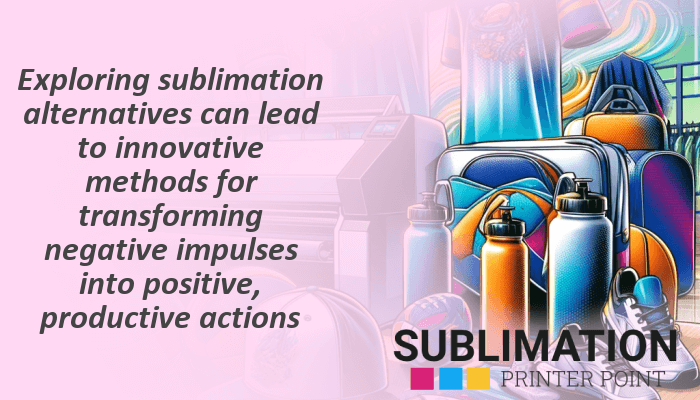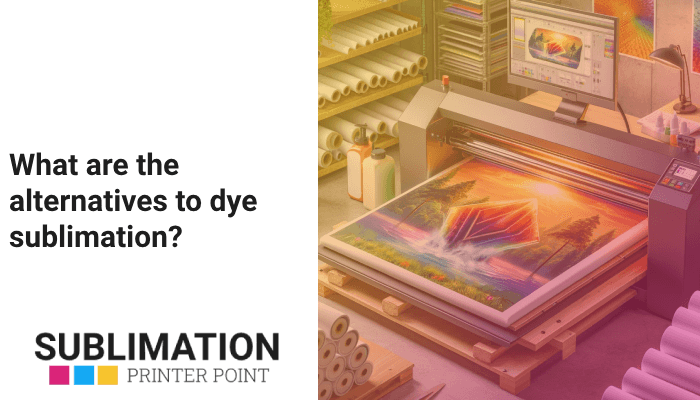Learn about non-sublimation printing methods, including direct-to garment printing (DTG), thermal transfer, screen printing, digital printing and vinyl cutting. Each offers unique advantages and applications, providing a viable alternative to sublimation.
A variety of non-sublimation printing techniques are available as substitutes for dye sublimation, each with special advantages and uses. DTG printing provides a wide range of colors and excellent print quality. Heat transfer printing is a flexible and easy-to-use method. For larger orders, screen printing is recognized for its affordability and robustness. Fast turnaround times and excellent print quality are provided by digital printing. Vinyl cutting is well-liked because of its adaptability and durability.
- DTG printing uses specialized printers to spray water-based inks onto the fabric, making it effective for intricate designs.
- Heat transfer printing involves transferring a design from a special type of paper onto a garment using heat and pressure.
- Screen printing involves creating a stencil (or screen) and using it to apply layers of ink onto the printing surface.
- Digital printing involves printing digital-based images directly onto a variety of media, bypassing the need for a printing plate.
- Vinyl cutting involves cutting a design out of vinyl and then applying it to a surface using heat or pressure.
| Printing Method | Description | Advantages | Disadvantages |
|---|---|---|---|
| Direct to Garment (DTG) | A digital process that directly imprints ink onto textiles and apparel. | High-quality prints, broad color spectrum, compatibility with various fabric types, ideal for intricate designs and small batch orders. | Prints tend to fade faster, slower and more costly for large orders. |
| Heat Transfer Printing | Transfers a design from a special type of paper onto a garment using heat and pressure. | Versatile, user-friendly, effective for designs with solid colors and simple graphics. | Less durable than dye sublimation, the print sits on top of the fabric rather than becoming part of it. |
| Screen Printing | Creates a stencil (or screen) and uses it to apply layers of ink onto the printing surface. | Durable, cost-effective for large orders, can be used on a variety of materials. | Complex process, each color requires a separate screen, less suitable for complex, multi-colored designs. |
| Digital Printing | Prints digital-based images directly onto a variety of media. | High-quality prints, quick turnaround times, cost-effective for small orders, excellent for personalized and variable data printing. | Less durable than other methods, cost per unit can be higher for large orders. |
| Vinyl Cutting | Cuts a design out of vinyl and then applies it to a surface using heat or pressure. | Durable, versatile, can be used on a wider range of materials and colors. | Less smooth than dye sublimation, less suitable for complex, multi-colored designs. |
A comparison of the various printing techniques, along with their benefits and drawbacks, is given in this table.
What is the essence of direct to garment printing?
One non-sublimation option is Direct to Garment (DTG) printing, which is a digital method that imprints ink directly onto fabrics and clothing. It’s an Epson-designed technique that replicates the design precisely by spraying water-based inks onto the fabric using specialist printers. This method works especially well for complex designs with lots of color. It’s important to realize that DTG printing is a different process with its own special benefits and uses, not just a substitute for sublimation.
How does direct to garment printing compare to dye sublimation?
Although they are both widely used printing techniques, DTG and dye sublimation take somewhat different approaches. Cotton is among the many materials that can be printed on with DTG printing, unlike sublimation, which needs surfaces made of polyester. DTG is also a great sublimation alternative for intricate, multicolored graphics since it has a more vivid color scheme. It’s important to remember, though, that dye sublimation frequently offers better fade resistance and longevity.
What are the advantages and disadvantages of direct to garment printing?
DTG printing has many advantages, such as excellent print quality, a wide range of color options, and suitability for a variety of fabric kinds. For small batch orders and delicate designs, it’s the perfect option. It is not without limitations, though. DTG prints can be slower and more expensive to produce for large orders, and they have a tendency to fade more quickly than sublimation prints. Consequently, it’s critical to take these things into account while selecting a sublimation substitute.
Did you know that the Direct to Garment (DTG) printing technique was designed by renowned electronics company Epson? It demonstrates their dedication to quality and innovation in the printing sector.
How does heat transfer printing serve as an alternative?
Another option to sublimation is heat transfer printing, which is applying pressure and heat to a specific kind of paper to transfer a design onto a garment. This technique, which is frequently linked to companies like Cricut and Silhouette, is well-liked among DIY enthusiasts and Bright Star Crafters due to its versatility and ease of usage. It is an alternative technique to sublimation, with an own set of advantages and uses.
What is the process of heat transfer printing?
A design is printed onto heat transfer paper to start the heat transfer printing process. After that, the garment is covered with this design, and pressure and a high temperature are applied using a heat press. A vivid and long-lasting print is produced when the design transfers from the paper to the cloth because to the heat. This technique works especially well for designs with straightforward visuals and solid color schemes.
How does heat transfer printing differ from dye sublimation?
Heat transfer printing and dye sublimation are similar techniques that use pressure and heat, but they work differently in terms of application and outcome. Heat transfer printing is more adaptable than sublimation printing since it can be applied to a greater variety of materials, such as cotton and dark textiles. However, because the ink is integrated into the fabric rather than just sitting on top of it, dye sublimation gives greater longevity and a smoother feel.
What makes screen printing a viable substitute?
An excellent substitute for sublimation printing is the time-tested method of screen printing. This technique entails making a stencil, sometimes known as a screen, and applying ink layers to the printing surface using it. Screen printing is a popular option for businesses and AOP (all-over print) designs because of its reputation for durability and affordability for large orders.
When selecting a sublimation replacement, take your needs into account. DTG can be the best option if you want complex, multicolored patterns. Heat transfer or vinyl cutting might be more appropriate for simple graphics and solid colors.
What is the process involved in screen printing?
Making a stencil of the design on a fine mesh screen is the first step in the screen printing process. The clothing is then inked by pushing ink through this screen. Designs with few colors work best with this strategy because each color in the design needs its own screen. Screen printing is a good substitute for sublimation because of its vibrancy and endurance, even with its complexity.
How does screen printing compare to dye sublimation?
Dye sublimation and screen printing are not the same. Screen printing can be done on a range of materials and with lower heat levels than sublimation, which needs polyester textiles and high temperatures. For businesses, screen printing is a viable substitute for sublimation because it is also more affordable for larger orders. On the other hand, sublimation provides greater versatility for intricate, multicolored graphics.
How does digital printing compare to dye sublimation?
Another non-sublimation printing method is digital printing, which prints images based on digital technology directly onto a range of substrates. This approach can save time and money because it does not require a printing plate. It’s crucial to remember that dye sublimation and digital printing are two distinct processes, each with advantages and disadvantages of its own.
What is the process of digital printing?
Digital printing is the method of printing an image straight from a digital file onto a media. Large-format and/or high-volume laser or inkjet printers are used for this. This method’s primary benefit is its capacity to create incredibly precise images in a broad color spectrum. It’s a popular alternative to sublimation because it’s a flexible method that works with a range of materials.
What are the pros and cons of digital printing?
High-quality prints, short turnaround times, and affordability for modest orders are just a few benefits of digital printing. It’s a great option for printing variable and customizable info. Its durability is inferior to that of other techniques, such as dye sublimation, and for large orders, the cost per unit may increase. Thus, it’s imperative to take these things into account while selecting a sublimation replacement.
What role does vinyl cutting play as an alternative to dye sublimation?
In contrast to sublimation, vinyl cutting entails cutting a design out of the material and adhering it to a surface under pressure or heat. This technique is well-liked for its dependability and adaptability, and it’s frequently linked to companies like Scan N Cut. It is a special substitute for sublimation with a distinct set of advantages and uses.

What is the process of vinyl cutting?
Creating a design and then cutting it out of a vinyl sheet with a vinyl cutter are the steps involved in vinyl cutting. After the cut design has been weeded (extra vinyl is removed), the design is applied to the garment using a heat press. This technique works especially well for designs with straightforward visuals and solid color schemes.
How does vinyl cutting compare to dye sublimation?
Vinyl cutting and dye sublimation take different approaches, even though they both entail applying graphics to a surface. Vinyl cutting is a useful replacement for sublimation since it is more adaptable and works with a larger variety of materials and colors. On the other hand, dye sublimation provides more flexibility and a smoother feel for intricate multicolored designs.

